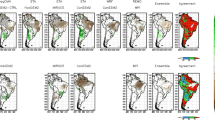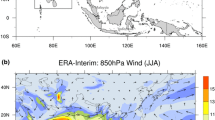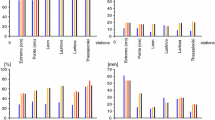Abstract
The study compares characteristics of observed sub-daily precipitation extremes in the Czech Republic with those simulated by Hadley Centre Regional Model version 3 (HadRM3) and Rossby Centre Regional Atmospheric Model version 4 (RCA4) regional climate models (RCMs) driven by reanalyses and examines diurnal cycles of hourly precipitation and their dependence on intensity and surface temperature. The observed warm-season (May–September) maxima of short-duration (1, 2 and 3 h) amounts show one diurnal peak in the afternoon, which is simulated reasonably well by RCA4, although the peak occurs too early in the model. HadRM3 provides an unrealistic diurnal cycle with a nighttime peak and an afternoon minimum coinciding with the observed maximum for all three ensemble members, which suggests that convection is not captured realistically. Distorted relationships of the diurnal cycles of hourly precipitation to daily maximum temperature in HadRM3 further evidence that underlying physical mechanisms are misrepresented in this RCM. Goodness-of-fit tests indicate that generalised extreme value distribution is an applicable model for both observed and RCM-simulated precipitation maxima. However, the RCMs are not able to capture the range of the shape parameter estimates of distributions of short-duration precipitation maxima realistically, leading to either too many (nearly all for HadRM3) or too few (RCA4) grid boxes in which the shape parameter corresponds to a heavy tail. This means that the distributions of maxima of sub-daily amounts are distorted in the RCM-simulated data and do not match reality well. Therefore, projected changes of sub-daily precipitation extremes in climate change scenarios based on RCMs not resolving convection need to be interpreted with caution.







Similar content being viewed by others
References
Anderson TW, Darling DA (1952) Asymptotic theory of certain ‘goodness of fit’ criteria based on stochastic processes. Ann Math Stat 23:193–212
Ban N, Schmidli J, Schär C (2015) Heavy precipitation in a changing climate: does short-term summer precipitation increase faster? Geophys Res Lett 42:1165–1172
Blenkinsop S, Chan SC, Kendon EJ, Roberts NM, Fowler HJ (2015) Temperature influences on intense UK hourly precipitation and dependency on large-scale circulation. Environ Res Lett 10:054021. doi:10.1088/1748-9326/10/5/054021
Blenkinsop S, Lewis E, Chan SC, Fowler HJ (2016) Quality-control of an hourly rainfall dataset and climatology of extremes for the UK. Int J Climatol. doi:10.1002/joc.4735
Brisson E, van Weverberg K, Demuzere M, Devis A, Saeed S, Stengel M, van Lipzig NPM (2016) How well can a convection-permitting climate model reproduce decadal statistics of precipitation, temperature and cloud characteristics? Clim Dynam. doi:10.1007/s00382-016-3012-z
Brockhaus P, Lüthi D, Schär C (2008) Aspects of the diurnal cycle in a regional climate model. Meteorol Z 17:433–443
Chan SC, Kendon EJ, Fowler HJ, Blenkinsop S, Roberts NM (2014a) Projected increases in summer and winter UK sub-daily precipitation extremes from high-resolution regional climate models. Environ Res Lett 9:084019. doi:10.1088/1748-9326/9/8/084019
Chan SC, Kendon EJ, Fowler HJ, Blenkinsop S, Roberts NM, Ferro CAT (2014b) The value of high-resolution Met Office regional climate models in the simulation of multihourly precipitation extremes. J Clim 27:6155–6174
Chan SC, Kendon EJ, Roberts NM, Fowler HJ, Blenkinsop S (2016) Downturn in scaling of UK extreme rainfall with temperature for future hottest days. Nat Geosci 9:24–28
Chen C-T, Knutson T (2008) On the verification and comparison of extreme rainfall indices from climate models. J Clim 21:1605–1621
Chen H, Zhou T, Yu R, Li J (2009) Summer rain fall duration and its diurnal cycle over the US Great Plains. Int J Climatol 29:1515–1519
Coles S (2001) An introduction to statistical modeling of extreme values. Springer, Berlin
Collins M, Booth BBB, Harris GR, Murphy JM, Sexton DMH, Webb MJ (2006) Towards quantifying uncertainty in transient climate change. Clim Dynam 27:127–147
Dai A, Lin X, Hsu K-L (2007) The frequency, intensity, and diurnal cycle of precipitation in surface and satellite observations over low- and mid-latitudes. Clim Dynam 29:727–744
Dee DP, Uppala SM, Simmons AJ et al (2011) The ERA-Interim reanalysis: configuration and performance of the data assimilation system. Q J Roy Meteor Soc 137:553–597
Evans JP, Westra S (2012) Investigating the mechanisms of diurnal rainfall variability using a regional climate model. J Clim 25:7232–7247
Flato G et al (2013) Evaluation of climate models. In: Working Group 1 Contribution to the IPCC Fifth Assessment Report—Climate Change: The Physical Science Basis. Cambridge Univ Press, Cambridge, UK and New York
Gaál L, Beranová R, Hlavčová K, Kyselý J (2014) Climate change scenarios of precipitation extremes in the Carpathian region based on an ensemble of regional climate models. Adv Meteorol ID 943487. doi:10.1155/2014/943487
Gochis DJ, Shuttleworth WJ, Yang Z-L (2002) Sensitivity of the modeled North American monsoon regional climate to convective parameterization. Mon Weather Rev 130:1282–1298
Gregersen IB, Sørup HJD, Madsen H, Rosbjerg D, Mikkelsen PS, Arnbjerg-Nielsen K (2013) Assessing future climatic changes of rainfall extremes at small spatio-temporal scales. Clim Chang 118:783–797
Gregory D, Allen S (1991) The effect of convective scale downdrafts upon NWP and climate simulations. In: Ninth Conference on Numerical Weather Prediction. Denver, Colorado, American Meteorological Society, pp 122–123
Gregory D, Rowntree PR (1990) A mass flux convection scheme with representation of cloud ensemble characteristics and stability dependent closure. Mon Weather Rev 118:1483–1506
Hanel M, Buishand TA (2010) On the value of hourly precipitation extremes in regional climate model simulations. J Hydrol 393:265–273
Hanel M, Máca P (2014) Spatial variability and interdependence of rain event characteristics in the Czech Republic. Hydrol Process 28:2929–2944
Hanel M, Buishand TA, Ferro CAT (2009) A nonstationary index flood model for precipitation extremes in transient regional climate model simulations. J Geophys Res 114:D15107. doi:10.1029/2009JD011712
Hanel M, Pavlásková A, Kyselý J (2016) Trends in characteristics of sub-daily heavy precipitation and rainfall erosivity in the Czech Republic. Int J Climatol 36:1833–1845
Haylock MR, Hofstra N, Klein Tank AMG, Klok EJ, Jones PD, New M (2008) A European daily high-resolution gridded data set of surface temperature and precipitation for 1950–2006. J Geophys Res 113:D20119. doi:10.1029/2008JD010201
Hofstra N, New M, McSweeney C (2009) The influence of interpolation and station network density on the distribution and extreme trends of climate variables in gridded data. Clim Dynam 35:841–858
Jeong J-H, Walther A, Nikulin G, Chen D, Jones C (2011) Diurnal cycle of precipitation amount and frequency in Sweden: observation versus model simulation. Tellus 63A:664–674
Jones RG, Noguer M, Hassell DC, Hudson D, Wilson SS, Jenkins GJ, Mitchell JFB (2004) Generating high-resolution climate change scenarios using PRECIS. Exeter, UK, available from Met Office Hadley Centre
Kain JS (2004) The Kain–Fritsch convective parameterization: an update. J Appl Meteorol Clim 43:170–181
Kain JS, Fritsch JM (1990) A one-dimensional entraining/detraining plume model and its application in convective parameterization. J Atmos Sci 47:2784–2802
Kendon EJ, Roberts NM, Senior CA, Roberts MJ (2012) Realism of rainfall in a very high-resolution regional climate model. J Clim 25:5791–5806
Klein Tank AMG, Zwiers FW, Zhang X (2009) Guidelines on analysis of extremes in a changing climate in support of informed decisions for adaptation. WMO-TD No. 1500, 56 pp
Kojadinovic I, Yan J (2012) Goodness-of-fit testing based on a weighted bootstrap: a fast large-sample alternative to the parametric bootstrap. Can J Stat 40:480–501
Květoň V, Zahradníček J, Žák M (2004) Quality control and digitising of pluviographic measurements in the Czech Hydrometeorological Institute. Meteorologické zprávy 57:47–52 in Czech, with summary in English
Kyselý J, Beguería S, Beranová R, Gaál L, López-Moreno JI (2012) Different patterns of climate change scenarios for short-term and multi-day precipitation extremes in the Mediterranean. Glob Planet Chang 98–99:63–72
Kyselý J, Rulfová Z, Farda A, Hanel M (2016) Convective and stratiform precipitation characteristics in an ensemble of regional climate model simulations. Clim Dynam 46:227–243
Laio F (2004) Cramér-von Mises and Anderson-Darling goodness of fit tests for extreme value distributions with unknown parameters. Water Resour Res 40:W09308. doi:10.1029/2004WR003204
Lenderink G, van Meijgaard E (2010) Linking increases in hourly precipitation extremes to atmospheric temperature and moisture changes. Environ Res Lett 5:025208
Li F, Collins WD, Wehner MF, Williamson DL, Olson JG, Algieri C (2011) Impact of horizontal resolution on simulation of extremes in an aqua-planet version of Community Atmospheric Model (CAM3). Tellus 63A:884–892
Massey FJ (1951) The Kolmogorov-Smirnov test for goodness of fit. J Am Stat Assoc 46:68–78
Overeem A, Holleman I, Buishand TA (2009) Derivation of a 10-year radar-based climatology of rainfall. J Appl Meteorol Clim 48:1448–1463
Overeem A, Buishand TA, Holleman I, Uijlenhoet R (2010) Extreme value modeling of areal rainfall from weather radar. Water Resour Res 46:W09514. doi:10.1029/2009WR008517
Pennelly C, Reuter G, Flesch T (2014) Verification of the WRF model for simulating heavy precipitation in Alberta. Atmos Res 135–136:172–192
Prein AF, Langhans W, Fosser G, Ferrone A, Ban N, Goergen K, Keller M, Tölle M, Gutjahr O, Feser F, Brisson E, Kollet S, Schmidli J, van Lipzig NPM, Leung R (2015) A review on regional convection-permitting climate modeling: demonstrations, prospects, and challenges. Rev Geophys 53:323–361
Rio C, Hourdin F, Grandpeix J-Y, Lafore J-P (2009) Shifting the diurnal cycle of parameterized deep convection over land. Geophys Res Lett 36:L07809. doi:10.1029/2008GL036779
Rulfová Z, Kyselý J (2013) Disaggregating convective and stratiform precipitation from station weather data. Atmos Res 134:100–115
Saidi H, Ciampittiello M, Dresti C, Ghiglieri G (2013) The climatic characteristics of extreme precipitations for short-term intervals in the watershed of Lake Maggiore. Theor Appl Climatol 113:1–15
Samuelsson P, Gollvik S, Hansson U, Jones C, Kjellström E, Nikulin G, Ullerstig A, Willén U, Wyser K (2011) The Rossby Centre Regional Climate Model RCA3: model description and performance. Tellus 63A:4–23
Sunyer MA, Luchner J, Onof C, Madsen H, Arnbjerg-Nielsen K (2016) Assessing the importance of spatio-temporal RCM resolution when estimating sub-daily extreme precipitation under current and future climate conditions. Int J Climatol. doi:10.1002/joc.4733
Svoboda V, Hanel M, Máca P, Kyselý J (2016) Characteristics of rainfall events in RCM simulations for the Czech Republic. Hydrol Earth Syst Sci Discuss. doi:10.5194/hess-2016-283
Trenberth KE, Dai A, Rasmussen RM, Parsons DB (2003) The changing character of precipitation. B Am Meteorol Soc 84:1205–1217
Uppala SM, Kållberg PW, Simmons AJ et al (2005) The ERA-40 re-analysis. Q J Roy Meteor Soc 612:2961–3012
van den Besselaar EJM, Klein Tank AMG, Buishand TA (2013) Trends in European precipitation extremes over 1951–2010. Int J Climatol 33:2682–2689
Walther A, Jeong J-H, Nikulin G, Jones C, Chen D (2013) Evaluation of the warm season diurnal cycle of precipitation over Sweden simulated by the Rossby Centre regional climate model RCA3. Atmos Res 119:131–139
Westra S, Fowler HJ, Evans JP, Alexander LV, Berg P, Johnson F, Kendon EJ, Lenderink G, Roberts NM (2014) Future changes to the intensity and frequency of short-duration extreme rainfall. Rev Geophys 52:522–555
Yaqub A, Seibert P, Formayer H (2011) Diurnal precipitation cycle in Austria. Theor Appl Climatol 103:109–118
Yin S, Chen D, Xie Y (2009) Diurnal variations of precipitation during the warm season over China. Int J Climatol 29:1154–1170
Acknowledgments
The study was supported by the Czech Science Foundation under project 14-18675S. The observed data were provided by the Czech Hydrometeorological Institute and prepared within projects VG20122015092 funded by the Ministry of the Interior of the Czech Republic and KLIMATEXT (CZ.1.07/2.3.00/20.0086) funded by the European Social Fund. The RCM simulations were carried out in the framework of the ENSEMBLES project (HadRM3) and the CORDEX initiative (RCA4). We thank E. Buonomo (Met Office) and G. Nikulin (SMHI) for providing the sub-daily RCM data and V. Svoboda (IAP/CULS) for the assistance with data processing. We also acknowledge the free availability of E-OBS from the ENSEMBLES project.
Author information
Authors and Affiliations
Corresponding author
Rights and permissions
About this article
Cite this article
Beranová, R., Kyselý, J. & Hanel, M. Characteristics of sub-daily precipitation extremes in observed data and regional climate model simulations. Theor Appl Climatol 132, 515–527 (2018). https://doi.org/10.1007/s00704-017-2102-0
Received:
Accepted:
Published:
Issue Date:
DOI: https://doi.org/10.1007/s00704-017-2102-0




